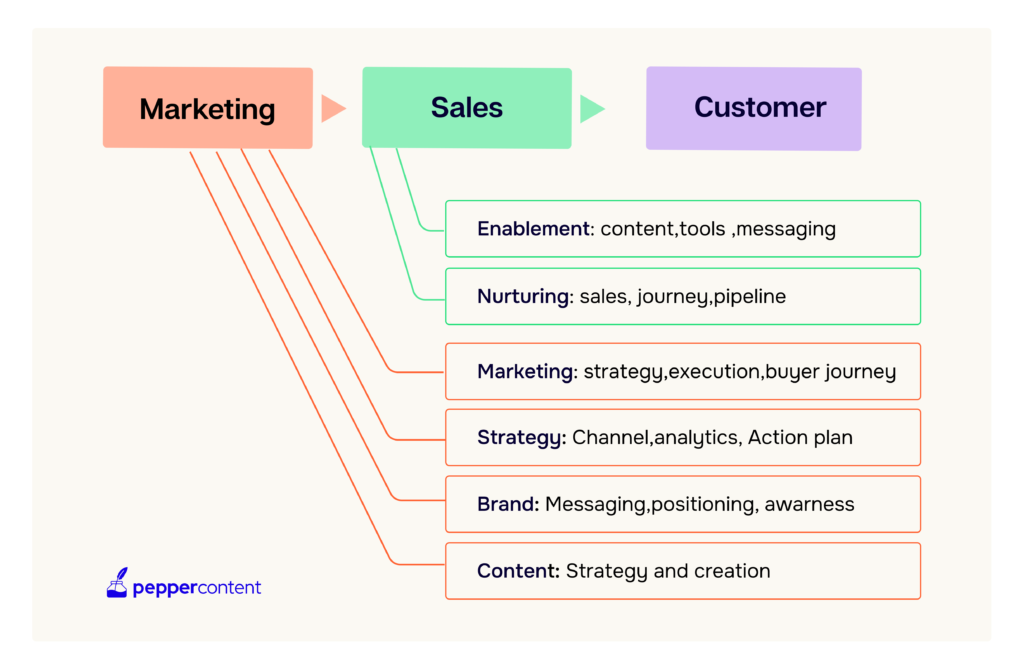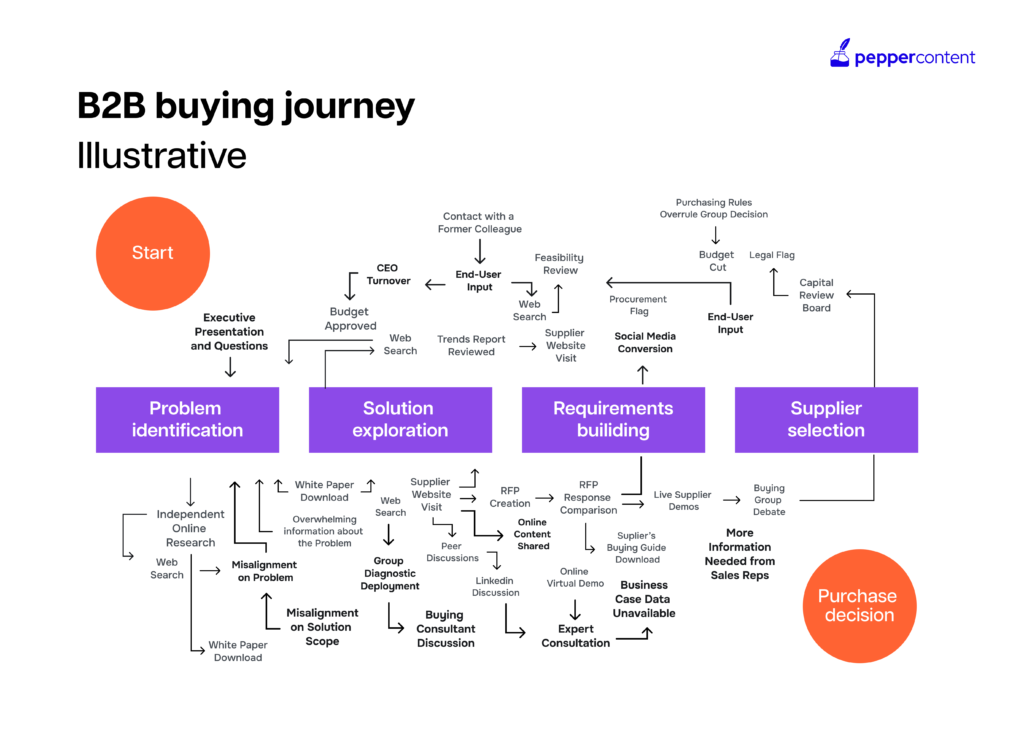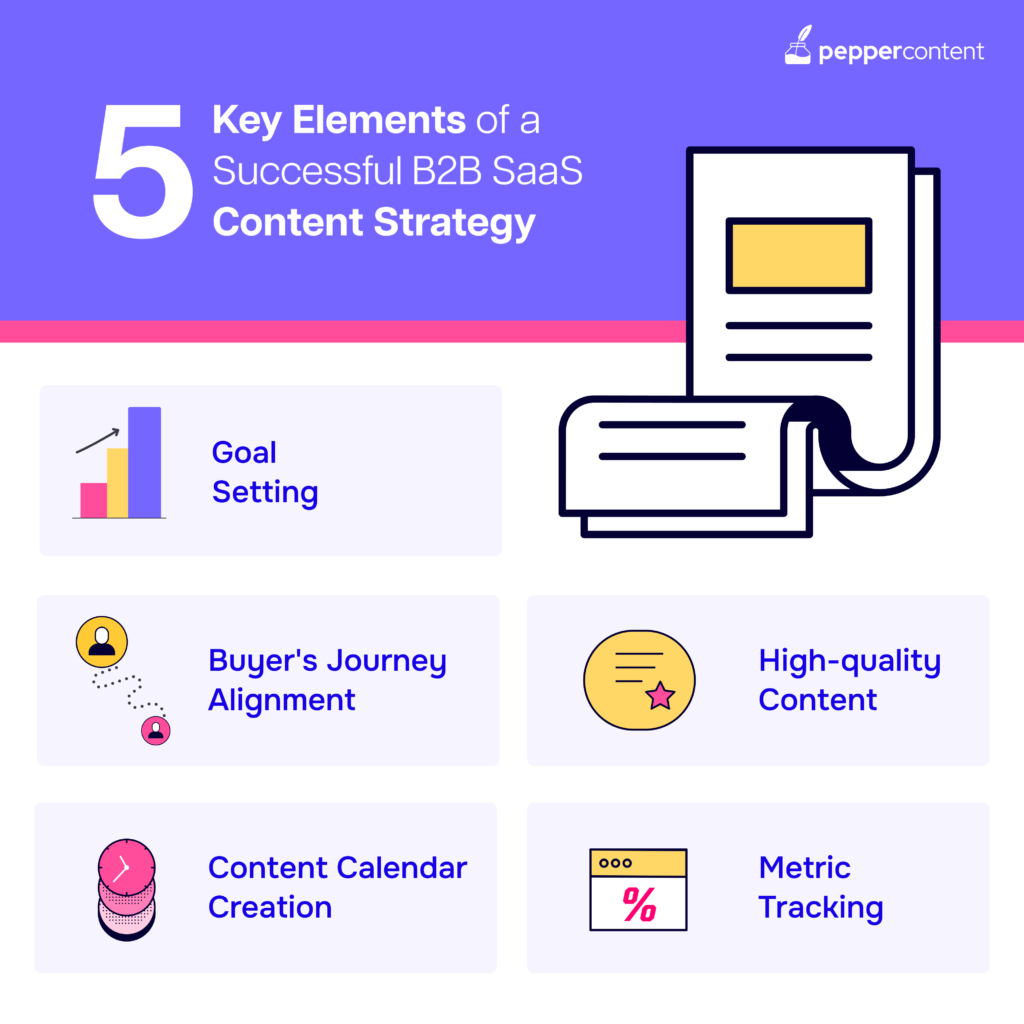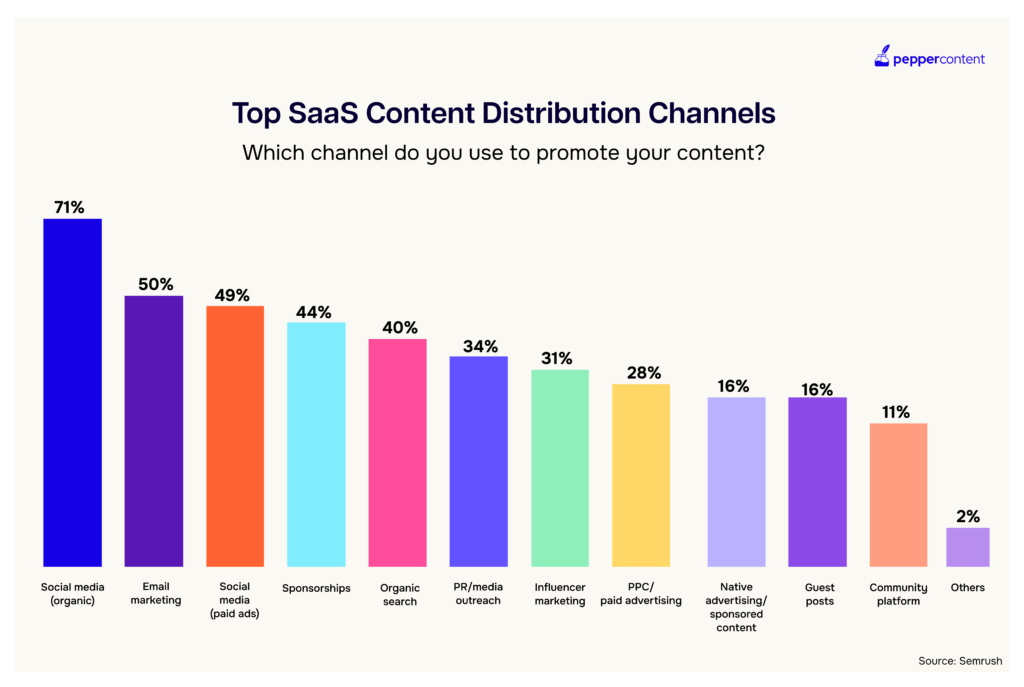Implementing a Power-packed B2B SaaS Content Marketing

When it comes to B2B SaaS content marketing, the stakes are high. The ever-evolving digital landscape has made it increasingly challenging for SaaS companies to build their reputation, earn trust, and educate their target audience. But fear not! With the right strategies and implementation techniques, you can unlock the power of content marketing to drive growth and establish thought leadership in the industry.
Unlike traditional marketing tactics, content marketing offers a long-term approach that focuses on providing value and building relationships with your audience. It’s about creating engaging, informative, and shareable content that resonates with your target customers.
For SaaS companies, this is particularly crucial. In an industry where trust and credibility are paramount, content marketing acts as a gateway to establishing authority and showcasing expertise. Successful SaaS companies have leveraged content marketing to attract customers by providing valuable educational resources that address pain points and offer solutions.
In this guide, we’ll delve into the key strategies and implementation techniques that can help you master B2B SaaS content strategy. So let’s dive in and uncover the secrets to driving growth and standing out in the crowded SaaS marketplace.
Why Content Marketing Matters for SaaS Companies
In the world of B2B SaaS, where competition is fierce and prospects are well-informed, content marketing has become an invaluable tool for companies looking to establish their brand, build trust, and educate their audience.
SaaS companies face unique challenges when it comes to building reputation and trust. Unlike tangible products, SaaS solutions are intangible and require a level of expertise and understanding from the customer. This is where content marketing comes into play. By creating informative and educational content, SaaS companies can bridge the knowledge gap and position themselves as trusted advisors in their industry.
Content marketing not only helps SaaS companies gain visibility but also plays a crucial role in lead generation. By creating content that addresses the pain points of their target audience, SaaS companies can attract qualified leads who are actively seeking solutions to their problems. This targeted approach ensures that the right people are engaging with their brand and increases the chances of converting them into paying customers.

Understanding Your Target Audience
To master B2B SaaS content marketing, you must first understand your target audience. Knowing their needs, pain points, and preferences is crucial for creating content that resonates with them. In the B2B space, transactions often involve multiple decision-makers and influencers, making it even more important to tailor your content specifically for each stakeholder.
Creating buyer personas can help you gain valuable insights into your target audience. These personas are fictional representations of your ideal customers and provide a deep understanding of their motivations, challenges, and goals. By identifying the pain points of each persona, you can create content that addresses their specific needs.
By gaining a comprehensive understanding of your target audience, you can develop content that speaks directly to them. Whether it’s through blog posts, ebooks, or webinars, tailoring your content to address their pain points will attract and engage your ideal customers.
Developing Your Content Strategy
A well-defined content strategy acts as the roadmap to success in B2B SaaS content marketing. It provides direction, clarity, and purpose to your content efforts. Without a strategy in place, you risk creating content that lacks relevance and fails to resonate with your target audience.
Set clear goals
First and foremost, it is crucial to set clear goals for your content marketing. Are you aiming to increase brand awareness? Generate leads? Convert prospects into customers? By clearly defining your objectives, you can align your content strategy accordingly.
Identify key metrics
In addition to setting goals, it’s important to identify key metrics to measure the success of your content efforts. These metrics could include website traffic, engagement metrics such as time on page and bounce rate, lead conversions, or even revenue generated from content-driven campaigns. By tracking these metrics regularly, you can gauge the effectiveness of your strategy and make data-driven optimizations.
Focus on the buyer’s journey
Understanding the buyer’s journey is another critical aspect of developing a successful content strategy. Different types of content are needed at each stage of the buyer’s journey – awareness, consideration, and decision-making.
For example, at the awareness stage, you might create educational blog posts or videos that address common pain points faced by your target audience.
At the consideration stage, case studies and whitepapers showcasing the benefits of your product or service can be effective in building trust and credibility.
Finally, at the decision-making stage, providing detailed product comparisons or offering free trials can help convert prospects into paying customers.

Consistency
To ensure consistency and timely delivery of your content, creating a content calendar is essential. This calendar outlines the topics, formats, and publishing dates for each piece of content. It helps you stay organized and provides a visual overview of your content pipeline.
One SaaS company that has effectively implemented a content strategy is Intercom. Their blog focuses on providing in-depth resources for customer support professionals, positioning them as thought leaders in their industry. By consistently delivering high-quality content, Intercom has been able to attract and engage its target audience, resulting in increased brand awareness and customer loyalty.

Creating Compelling Content
In the world of B2B SaaS content marketing, the competition is fierce. With countless brands vying for attention, it’s crucial to create compelling, high-quality content that stands out from the crowd. But what exactly does compelling content look like, and how do you create it?
First and foremost, high-quality content is informative and educational. It provides value to your audience by addressing their pain points, answering their questions, or offering actionable insights. For some companies, B2B SaaS content writing means going beyond simply promoting your product or service. Instead, focus on becoming a trusted resource in your industry.
One effective way to achieve this is by leveraging various content formats. Blog posts are a popular choice, allowing you to dive deep into relevant topics and establish thought leadership. But don’t stop there – consider creating whitepapers, videos, webinars, or even podcasts to cater to different preferences and learning styles.
To truly make an impact with your B2B SaaS content writing content, it’s essential to back up your claims with research-backed insights and case studies. This not only enhances your credibility but also provides tangible evidence of how your product or service can solve real-world problems.
For example, Salesforce has built a reputation for creating valuable content through its extensive collection of case studies. By showcasing how their CRM software has helped businesses achieve success, they provide real-world examples that resonate with their target audience.
Characteristics of B2B SaaS Content Writing
B2B SaaS content writing is distinct from other forms of content writing. Here are some key characteristics of B2B SaaS content writing:
- Technical expertise
- Value-driven approach
- Audience segmentation
- Educational and informative
- Case studies and testimonials
Conversion-focused
Long-form and in-depth
Promoting and Distributing Your Content
Promoting and distributing your content is just as important as creating it. After all, what good is compelling content if it doesn’t reach your target audience? To maximize the impact of your B2B SaaS content marketing efforts, you need to have a robust promotion and distribution strategy in place.

Social Media
One of the most effective ways to promote your content is through social media. Platforms like LinkedIn, Twitter, and Facebook offer the perfect opportunity to engage with your target audience and share your valuable insights. Create captivating social media posts that highlight key takeaways from your content and encourage readers to click through to your website.
Email marketing
This is another powerful tool for content distribution. Build an email list of prospects and customers who are interested in your industry. Send them regular newsletters featuring your latest blog posts, case studies, or whitepapers. Personalize the emails based on their preferences and pain points to increase engagement.
Search engine optimization
SEO is crucial for improving visibility and driving organic traffic to your content. Conduct keyword research to identify relevant keywords that align with your target audience’s search queries. Optimize your website, blog posts, and landing pages with these keywords to increase organic rankings on search engines.
Content refresh
Content refresh is essential for a B2B SaaS marketing strategy as it helps you stay relevant, address changing customer needs, improve SEO, enhance user experience, establish thought leadership, repurpose existing assets, and gain a competitive advantage. By investing in content refresh, you can effectively engage your target audience, generate leads, and drive conversions for your B2B SaaS solution.
Repurposing
Repurposing content for different platforms is an effective way to reach a wider audience. Convert blog posts into podcasts or videos, create infographics or slideshows from whitepapers or reports. By repackaging your content in different formats, you can engage with different types of learners or individuals who prefer consuming content in different ways.
In conclusion, B2B SaaS content marketing and B2B SaaS content writing are powerful tools for driving growth and establishing thought leadership in the industry. By implementing effective strategies and techniques, SaaS companies can overcome the unique challenges they face and build trust with their target audience.
With careful planning and execution, SaaS companies can harness the power of content marketing and B2B SaaS content writing to build trust, establish thought leadership, and drive sustainable growth. By following the strategies and techniques outlined in this guide, you can unlock the full potential of B2B SaaS content marketing and propel your company to new heights. Get in touch with Pepper for all your B2B SaaS content writing needs!
Latest Blogs
Explore how Google’s 2025 AI search updates triggered ranking chaos. Learn actionable strategies to adapt your SEO for AI Overviews, zero-click searches, and SERP volatility. Stay ahead now.
Learn how to rank on AI search engines like ChatGPT, Perplexity, and Gemini by optimizing your content for authority, structure, and relevance. Stay ahead in AI-driven search with this strategic guide.
Explore the best healthcare SEO services for your medical practice. Improve online visibility and effectively reach more patients in need of your services.
Get your hands on the latest news!
Similar Posts

Content Strategy
5 mins read
Choosing The Best Healthcare Marketing Agency For Effective Content Solutions

Content Marketing
4 mins read
Top 10 Agencies B2B SaaS Content Marketing for B2B Success

B2C Marketing
5 mins read